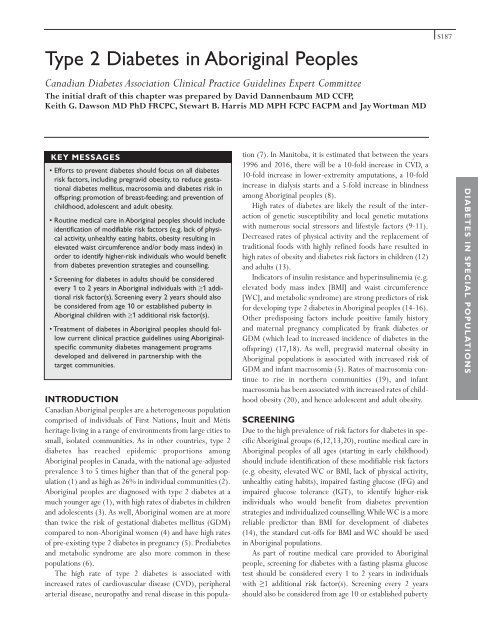2008 Clinical Practice Guidelines - Canadian Diabetes Association
2008 Clinical Practice Guidelines - Canadian Diabetes Association
2008 Clinical Practice Guidelines - Canadian Diabetes Association
You also want an ePaper? Increase the reach of your titles
YUMPU automatically turns print PDFs into web optimized ePapers that Google loves.
Type 2 <strong>Diabetes</strong> in Aboriginal Peoples<br />
<strong>Canadian</strong> <strong>Diabetes</strong> <strong>Association</strong> <strong>Clinical</strong> <strong>Practice</strong> <strong>Guidelines</strong> Expert Committee<br />
The initial draft of this chapter was prepared by David Dannenbaum MD CCFP,<br />
Keith G. Dawson MD PhD FRCPC, Stewart B. Harris MD MPH FCPC FACPM and Jay Wortman MD<br />
KEY MESSAGES<br />
• Efforts to prevent diabetes should focus on all diabetes<br />
risk factors, including pregravid obesity, to reduce gestational<br />
diabetes mellitus, macrosomia and diabetes risk in<br />
offspring; promotion of breast-feeding; and prevention of<br />
childhood, adolescent and adult obesity.<br />
• Routine medical care in Aboriginal peoples should include<br />
identification of modifiable risk factors (e.g. lack of physical<br />
activity, unhealthy eating habits, obesity resulting in<br />
elevated waist circumference and/or body mass index) in<br />
order to identify higher-risk individuals who would benefit<br />
from diabetes prevention strategies and counselling.<br />
• Screening for diabetes in adults should be considered<br />
every 1 to 2 years in Aboriginal individuals with ≥1 additional<br />
risk factor(s). Screening every 2 years should also<br />
be considered from age 10 or established puberty in<br />
Aboriginal children with ≥1 additional risk factor(s).<br />
• Treatment of diabetes in Aboriginal peoples should follow<br />
current clinical practice guidelines using Aboriginalspecific<br />
community diabetes management programs<br />
developed and delivered in partnership with the<br />
target communities.<br />
INTRODUCTION<br />
<strong>Canadian</strong> Aboriginal peoples are a heterogeneous population<br />
comprised of individuals of First Nations, Inuit and Métis<br />
heritage living in a range of environments from large cities to<br />
small, isolated communities. As in other countries, type 2<br />
diabetes has reached epidemic proportions among<br />
Aboriginal peoples in Canada, with the national age-adjusted<br />
prevalence 3 to 5 times higher than that of the general population<br />
(1) and as high as 26% in individual communities (2).<br />
Aboriginal peoples are diagnosed with type 2 diabetes at a<br />
much younger age (1), with high rates of diabetes in children<br />
and adolescents (3). As well, Aboriginal women are at more<br />
than twice the risk of gestational diabetes mellitus (GDM)<br />
compared to non-Aboriginal women (4) and have high rates<br />
of pre-existing type 2 diabetes in pregnancy (5). Prediabetes<br />
and metabolic syndrome are also more common in these<br />
populations (6).<br />
The high rate of type 2 diabetes is associated with<br />
increased rates of cardiovascular disease (CVD), peripheral<br />
arterial disease, neuropathy and renal disease in this popula-<br />
tion (7). In Manitoba, it is estimated that between the years<br />
1996 and 2016, there will be a 10-fold increase in CVD, a<br />
10-fold increase in lower-extremity amputations, a 10-fold<br />
increase in dialysis starts and a 5-fold increase in blindness<br />
among Aboriginal peoples (8).<br />
High rates of diabetes are likely the result of the interaction<br />
of genetic susceptibility and local genetic mutations<br />
with numerous social stressors and lifestyle factors (9-11).<br />
Decreased rates of physical activity and the replacement of<br />
traditional foods with highly refined foods have resulted in<br />
high rates of obesity and diabetes risk factors in children (12)<br />
and adults (13).<br />
Indicators of insulin resistance and hyperinsulinemia (e.g.<br />
elevated body mass index [BMI] and waist circumference<br />
[WC], and metabolic syndrome) are strong predictors of risk<br />
for developing type 2 diabetes in Aboriginal peoples (14-16).<br />
Other predisposing factors include positive family history<br />
and maternal pregnancy complicated by frank diabetes or<br />
GDM (which lead to increased incidence of diabetes in the<br />
offspring) (17,18). As well, pregravid maternal obesity in<br />
Aboriginal populations is associated with increased risk of<br />
GDM and infant macrosomia (5). Rates of macrosomia continue<br />
to rise in northern communities (19), and infant<br />
macrosomia has been associated with increased rates of childhood<br />
obesity (20), and hence adolescent and adult obesity.<br />
SCREENING<br />
Due to the high prevalence of risk factors for diabetes in specific<br />
Aboriginal groups (6,12,13,20), routine medical care in<br />
Aboriginal peoples of all ages (starting in early childhood)<br />
should include identification of these modifiable risk factors<br />
(e.g. obesity, elevated WC or BMI, lack of physical activity,<br />
unhealthy eating habits), impaired fasting glucose (IFG) and<br />
impaired glucose tolerance (IGT), to identify higher-risk<br />
individuals who would benefit from diabetes prevention<br />
strategies and individualized counselling.While WC is a more<br />
reliable predictor than BMI for development of diabetes<br />
(14), the standard cut-offs for BMI and WC should be used<br />
in Aboriginal populations.<br />
As part of routine medical care provided to Aboriginal<br />
people, screening for diabetes with a fasting plasma glucose<br />
test should be considered every 1 to 2 years in individuals<br />
with ≥1 additional risk factor(s). Screening every 2 years<br />
should also be considered from age 10 or established puberty<br />
S187<br />
DIABETES IN SPECIAL POPULATIONS











